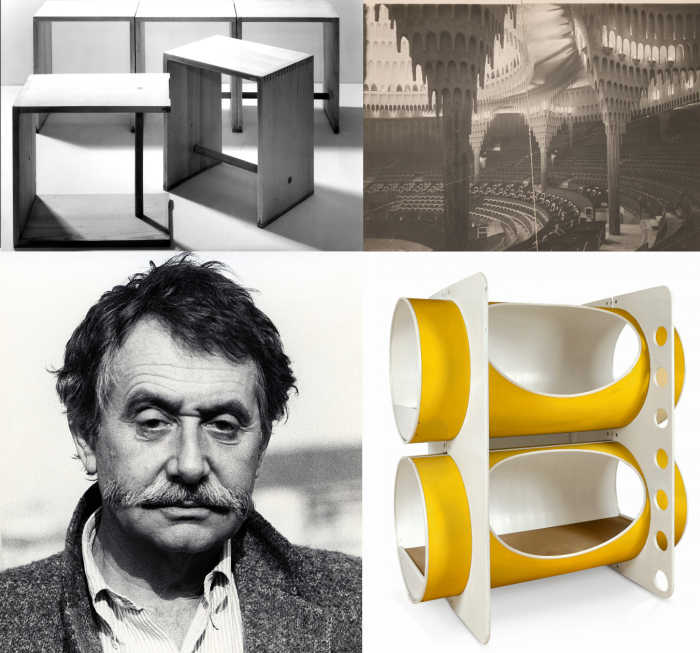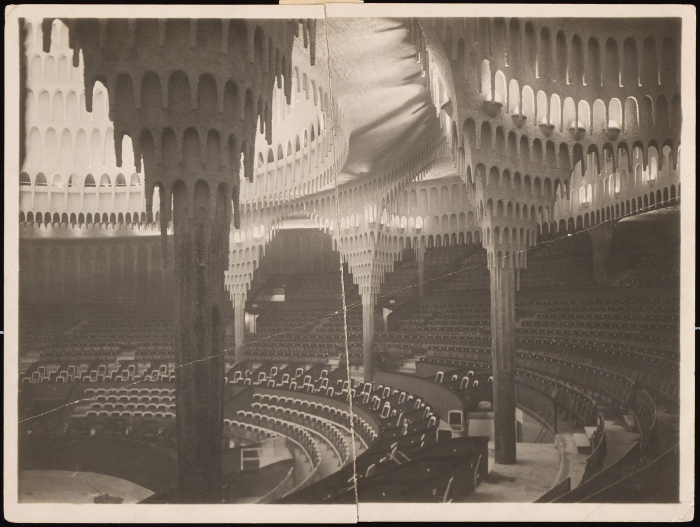In days of yore October was known in Germanic lands as Weinmonat, Wine Month, Month of Wine, whereby thoughts were, unquestionably, less with the drink as with the grape and the harvest, and thus the promise of the new wine.
And in many regards our exhibition recommendations can be considered a monthly harvest of the new crop of architecture and design exhibitions; specifically, and staying in Germanic registers, an Auslese, a considered selection of those well ripened concepts and premises it is hoped will most excite an invigorate the palate both experienced and novice. Or the viewer, experienced or novice.
Our quintet of, possible, new, memorable vintages from Weinmonat 2021 can be found in Ulm, Stockholm, ’s-Hertogenbosch, Paris and Tokyo.......

Although the Hochschule für Gesatltung, HfG, Ulm only existed between 1953 and 1968, it has, as oft noted, acquired a near mythical place in the (hi)story of design in West Germany. Has become, as is popularly proclaimed, Iconic. As has an item of furniture developed in the school for use in the school, but which has taken on an existence and attitude of its own: The Ulmer Hocker, the Ulm Stool, a stool which, as the title of the HfG's Archiv's new exhibition states has become, an Icon.
But before it did it was an Idea.
And for us that promises to be one of the more interesting components of the exhibtion, the (hi)story of the genesis, development and realisation of an object of furniture so simple, so logical, so archetypal, it is hard to believe someone had to develop it, that someone to had to design it. It's surely always existed!
While on the other side of the Icon, of and in the exhibition title, the HfG Archiv aim to chart the Ulmer Hocker as an Idol via impressions of its contemporary use and employment, that life of its own it has grown in to and the object of daily use it has become. Since the institution for which it was developed has ceased to be.
And thereby promises to be presentation that not only helps us all better understand the Ulmer Hocker, nor only better appreciate what the (hi)story of the Ulmer Hocker can teach us about furniture design, about the design of furniture, but also allow for some fresh insights into the (hi)story and legacy of the HfG Ulm. Before and after Icon.
The Ulmer Hocker: Idea ─ Icon ─ Idol is scheduled to open at the HfG-Archiv Ulm, Am Hochsträß 8, 89081 Ulm on Friday October 8th and run until Sunday February 27th. Please check the HfG Archiv website for current information regarding opening times, ticketing and safety/hygiene regulations.
In many regards one of the most important moments in the (hi)story of design in the United States of America involves a Nordic/American interchange: the Finn Eliel Saarinen offering the Missourian Charles Eames a Fellowship at Cranbrook Academy of Art, an institution which aside from family Saarinen included amongst its key teaching staff, and key contributors to the schools positions and foundations, the Swedish sculptor Carl Milles and the Finnish ceramicist Maija Grotell. An invitation Eames accepted, and which led to one of the more important strands of American Mid-Century Modernism.
However, as the title of the National Museum Stockholm's new exhibition underscores, Nordic/American, Scandinavian/American, interchanges in context of design started much earlier in the century. And were very much ongoing.
A co-production by the National Museum in partnership with Los Angeles County Museum of Art, Milwaukee Art Museum and the Nasjonalmuseet, Oslo, Scandinavian Design & USA aims to explore design in Scandinavia and America in context of not just direct cooperations and exchanges at a professional level, but also, for example, in context of the transfer of ideas, positions and objects through migration, for all from Scandinavia to the USA, or in context of the (mis)use of design as a tool of political and cultural policy.
A thus promises a wide ranging and varied conceptual basis backed up by a wide ranging and varied selection of objects, creative genres, creative positions and creatives, which should enable Scandinavian Design & USA to not only allow for differentiated perspectives of the development of design in America and Scandinavia throughout the 20th century, but also for differentiated perspectives on the popular understandings of the "Scandinavian Design" of the exhibition title.
Scandinavian Design & USA – People, Encounters and Ideas, 1890–1980 is scheduled to open at the National Museum, Södra Blasieholmshamnen 2, 111 48 Stockholm on Thursday October 14th and run until Sunday January 9th. Please check the National Museum website for current information regarding opening times, ticketing and safety/hygiene regulations.

While all the youth sub-cultures that have accompanied societies development are ongoing, continually find new followers..... arguably none more so than Goth. And whomever was once touched by the hand of Goth rarely loses their association with, or joyful satisfaction of, their dark streak.
Goth, it would appear, is immortal.
With the exhibition Goth – Designing Darkness the Design Museum Den Bosch aim to, if one will, (if one should), bring light into the darkness and explore not only the (hi)story of Goth but for all Goth as a component of cultural (hi)story, of the culture historical impact, relevance and importance of Goth, of the interplays between Goth and the rest of society, and to do that across a range and array of creative genres, including art, clothing, design and architecture.
And in doing so should not only help deconstruct a lot of the all too easy cliches that surround Goth, but also help explain the continual, and unyielding, allure that is Goth. And that for Old Goths, New Goths, Non Goths, Oh No! Goths! and Soon-to-be Goths alike.
And that not only, as the curators note, in a city with a gothic/baroque old town, but also in the birthplace of the at times astonishingly dark, yet simultaneously enlightening, Hieronymus Bosch.
Goth – Designing Darkness is scheduled to open at Design Museum Den Bosch, De Mortel 4, 5200 AA Den Bosch on Saturday October 16th and run until Monday April 18th. Please check the Design Museum Den Bosch website for current information regarding opening times, ticketing and safety/hygiene regulations.

Ettore Sottsass is, inarguably, one of the more enigmatic figures in the (hi)story of design, one of the more difficult characters to approach and understand; but an individual it is well worth approaching.
Promising a presentation of some 400 works, 500 photographs and 200 documents from the 1940s to the 1980s and covering the wide array of genres in which Sottsass was active, Ettore Sottsass. The Magic Object should allow not only a fulsomely illustrated introduction to the Sottsass biography, but for all, and for all through its promised extensive scope and variety, help elucidate how that biography contributed to and informed the many, and varied, phases and moments of Sottsass's career. And how the courses of Sottsass career(s), and the deviations he made, contributed to not only the complexity of approaching Sottsass but were and are that which allowed and enabled him to contribute to development of design understandings and design approaches to the degree he did.
And thereby help better explain why Ettore Sottsass is one of the more important figures in the (hi)story of design.
And thereby why Ettore Sottsass is a character well worth approaching and understanding. Not least on account of the enigma.
Ettore Sottsass. The Magic Object is scheduled to open at the Center Pompidou, Place Georges-Pompidou, 75004 Paris on Wednesday October 13th and run until Tuesday January 4th. Please check the Center Pompidou website for current information regarding opening times, ticketing and safety/hygiene regulations.

The richness and diversity of the (hi)story of craft and design in Europe does tend to enforce a very Eurocentric view of craft and design in Europe and amongst Europeans; or put another way, in Europe we tend to become so absorbed with our own (hi)stories we forget that there are other (hi)stories of craft and design out there.
Other (hi)stories of craft and design that could help us better understand the (hi)stories we are so absorbed in and with.
(Hi)stories such as Mingei.
Arsing in Japan in the 1920s the Mingei movement, and simplifying dangerously, sought a primacy of traditional craft materials and process, was, if one will, and as with parallel moments in Europe, a critical and questioning response to the industrialisation and urbanisation of the late 19th/early 20th centuries. And, as the curators of 100 Years of Mingei note, was such not just in terms of objects but also in terms of the networks and frameworks within which production, distribution and consumption occurred, and thus a movement aware of the complex relationships between societies and their objects of daily use.
And arising as it did towards the end of Art Nouveau there's the very pertinent question of a possible European influence on Mingei, a question that becomes more fascinating when one considers the Japanese influences on first Art Nouveau and subsequently on international Modernism, and, we hope,100 Years of Mingei will allow some insights into the ¿two way? exchange between Japan and Europe in the course of the 19th and 20th centuries.
But for all 100 Years of Mingei should allow for interesting insights into the development of not only design understandings in Japan but of Japan's understanding and reception of its (¿perceived?) cultural heritage, and the place of its traditional crafts in contemporary society, and thereby enable a better charting of the route craft and design have taken in Japan.
100 Years of Mingei is scheduled top open at the National Museum of Modern Art, 3-1 Kitanomaru-koen, Chiyoda-ku, Tokyo 102-8322 on Tuesday October 26th and run until Sunday February 13th. Please check the National Museum of Modern Art website for current information regarding opening times, ticketing and safety/hygiene regulations.
